2007 VOLKSWAGEN GOLF oil change
[x] Cancel search: oil changePage 318 of 444
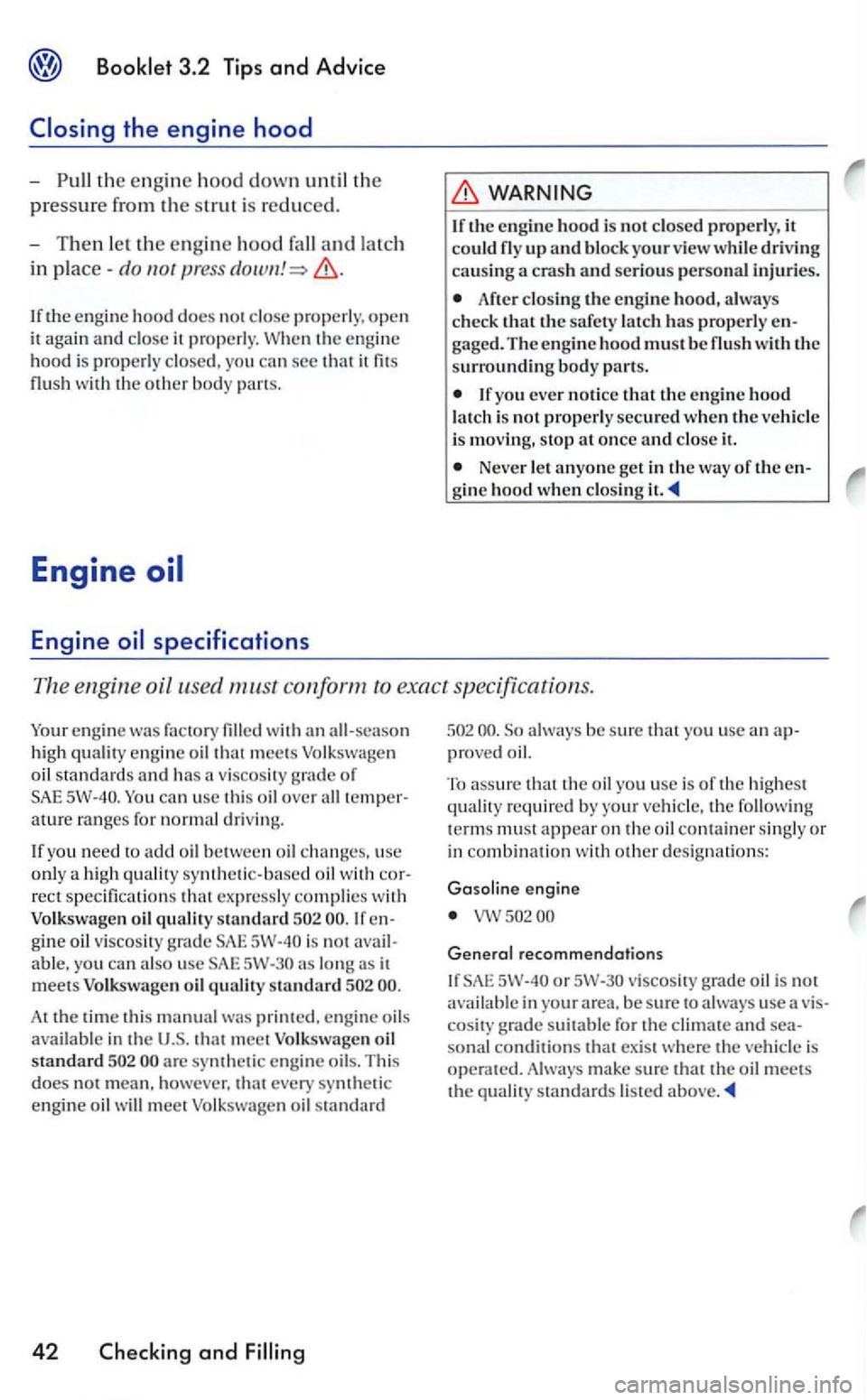
the engine hood down th e
pressure fro m the strut is reduced.
- Then the en g in e hood
in
If the engine hood does not close properly, open
it agai n and close it properly. the engi ne
hood i s yo u can sec that it fits with the other body pans.
Engine
If the en gin e hood is not closed prope rly, it could up and block your while driv ing cau sing a crash and serious person a l injuries.
Afte r closing the engine hood, always
c heck that the latch has properly gaged. The engine hood must be with the
surrounding body p a rts.
If you ever n otice that the engin e hood latch is not properl y secured w he n the vehicl e
i s mov in g, stop at once and close it.
Neve r le t anyone get in the way of the gine hood when clos in g
Th e engine oil use d co nform to exact specifications.
en g in e was with an meets
can usc thi s oil over all ature ranges for normal driving.
If you need to add between oil changes, use only a hi gh synt hetic-based oil w ith rect specificatio ns that express ly complies with oil qua li ty standard gine oil v iscosity grade is able. yo u can also use as long as it meets oil quality standard
arc synthetic engine oils. This does no t mean, however, that every synthetic engine oil will meet
and
always be sure that yo u u se an
th e term s must appear o n the oil container si ngly o r
in combination w ith other designations:
Gasoline engine
General recommendations
or
Page 322 of 444
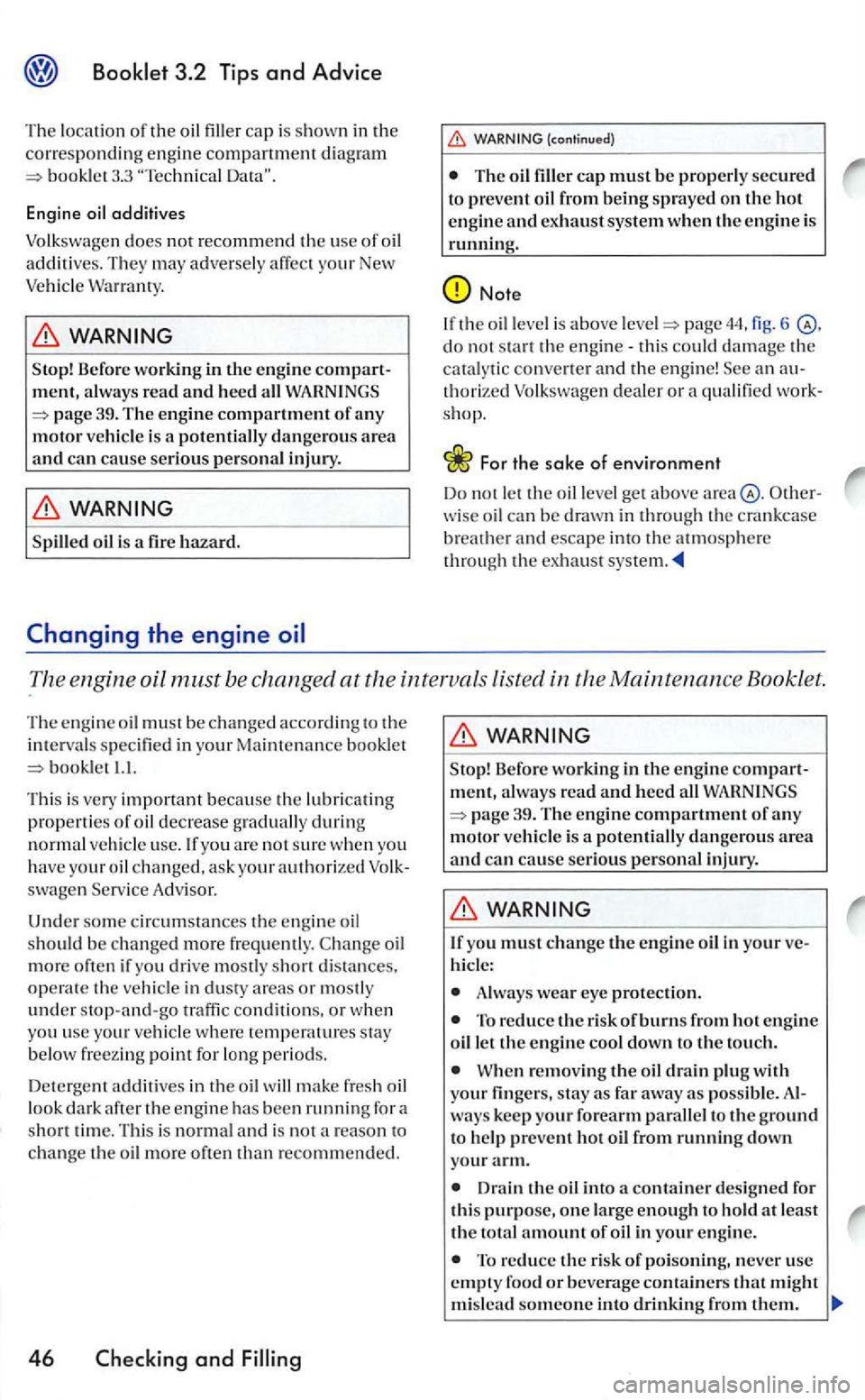
3.3
additives
Volkswagen
does not recommend the use of oil additives. They may adversel y affec t your New Vehicl e
Befor e worki ng in the engine compart
m ent, a lw ays read and heed all
Spilled oil is a fire hazard.
Changing the engine oil
(continued)
The oil filler cap must b e properly secured
to prevent oil from being sprayed o n the hot e ngine and exhaust system w hen the engin e is running.
th e oil is above pag e 44, fig. 6 do not start t he engine-thi s c ould damage the cata lytic convert er a nd the en g ine! a n au
t h orized Volkswage n dealer or a qualified work
s hop.
Fo r the sake of environment
Do not the oil leve l ge t above Other
wise oil can be drawn in throu gh the cra nkcase breather and escape in to the atmosp he re
throug h the exhaust system.
Th e engine oil must be changed at the interuals listed in the Maintenanc e Booklet .
The engine oil must b e changed according to the int erv a ls s pecified in your Maintenance booklet book le t 1.1.
Thi s is ve ry important beca use th e lubricatin g
prop ertie s of oil decreas e gra dually during
n ormal ve hicl e use . yo u arc not sure w hen you
hav e yo ur oil changed , ask your authorized Volkswagen Service A dvisor.
Und er
som e c irc um sta nc es the engin e oil
shoul d b e changed more frequently. more often if yo u drive mostly short distances. ope ra te the ve hicle in dusty area s or mostly under s top -and-go traffic conditi ons, or w hen
yo u use vehicle where stay
below fre e zin g point for long period s.
D eterg e
nt addit ive s in the oil will make fr es h oil
look dar k after the engine has been running for a short tim e. This is norm al and is not a reaso n to
c h a nge the oil more often than recommend ed .
46 Checking and
Before working in the engine compart
m ent, alway s read and heed a ll
yo u must chan ge the en gin e oil in your ve
hicl e:
Alwa ys wear eye protectio n.
To reduce the riskofburns from ho t engine
oil l e t the e ngine cool down to the to u ch.
W hen r emoving the oil dra in plu g with your fin gers, stay as far away as possibl e. Al
ways keep your forearm paralle l to the ground to help prevent hot oil from running down your arm.
Dra in the oil into a containe r designed for this purpose, one large enough to ho ld at least the tota l amount of oil in your engine.
To reduce the risk of poisoning, n e ver u se
empty food or beverage containe rs that might mis lead someon e into drinking from th em .
Page 323 of 444
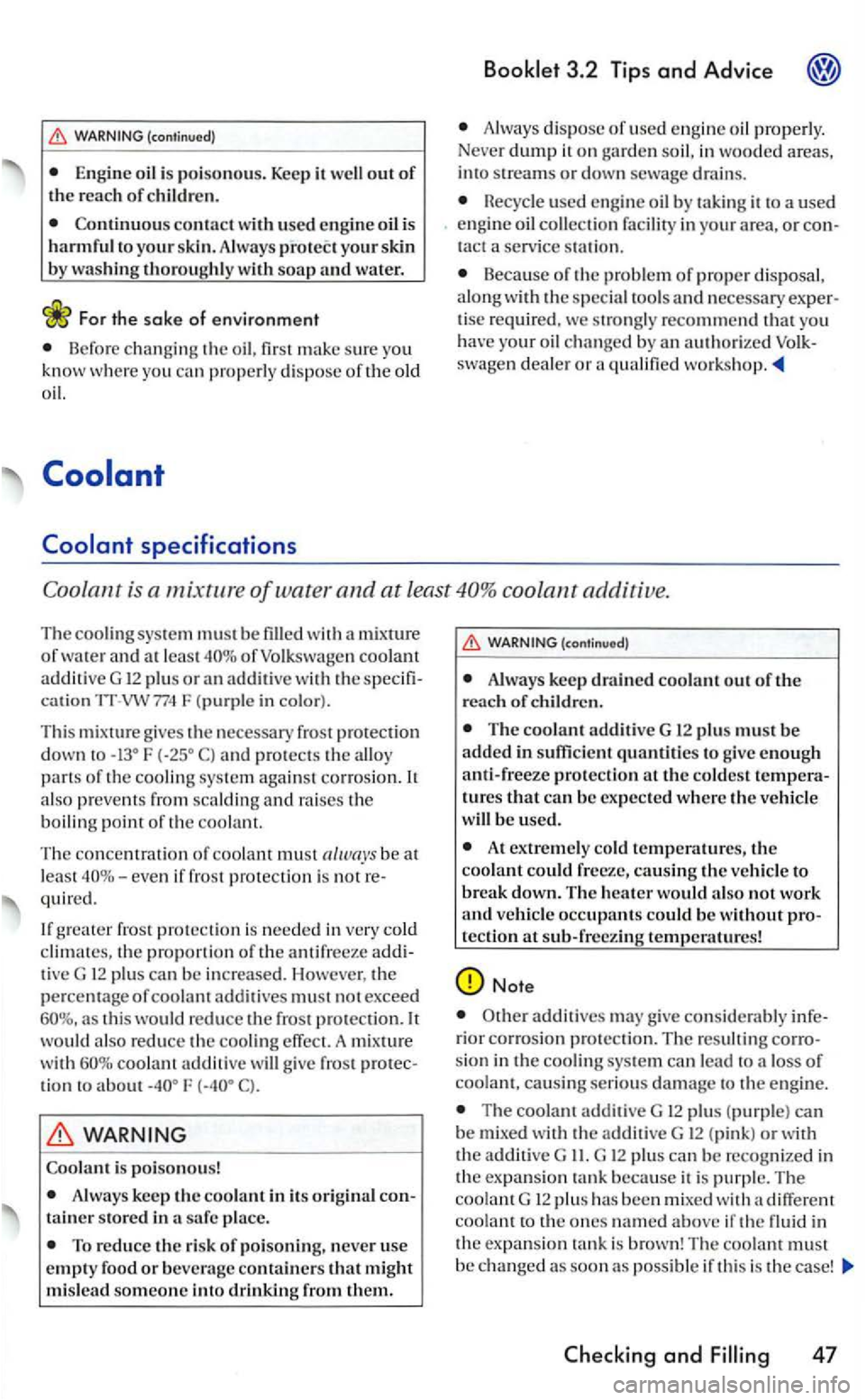
(cont;nuod)
Engine oil is po isonous. Keep it well out of the reach of child ren.
your skin by washing thoroughly w ith soap and wat er.
Fo r the sa ke of envir onment
Be fore changing oil, firs t m ake sure you kn ow where yo u can properly dispos e of the ol d
oil.
Alw ays d ispose of used engine oil properl y.
Neve r dump it on garden soil , in wooded area s,
int o streams or down sewage drains.
Recycle used eng in e oil by it to a u sed
eng in e oil colle ction fa ciliry in your area , o r ta ct a servic e sta tio n.
Because of t he proble m of proper disposal,
a long w ith the s pecial tools and n ecess ary tise re quired , we stro ngl y recommend that you hav e your oil changed by an authorize d swagen deale r or
Coolant is a mixture of wate r and at least cool ant additive.
The coolin g sys te m must be filled w ith mixture
o f water and of Volk s wa ge n coolant additive G 12 plu s or cati on
F and protects the alloy parts of the coolin g sys te m again st c o rrosio n. It
a lso prevent s from scalding and rai se s the
boiling point o f th e c oo la nt.
T he
concentration of coolant mus t be at leas t eve n if frost prote c tion is not quired .
If
greater fro st prot ection is needed in very cold climates, the proportion of the antifree ze ti ve G plu s can be in cre a se d. How ever, the percentage of coo as th is would reduce the fro st protectio n. would also reduce the c ooli ng effect. A mixture
with coolant additiv e will g iv e fro st tion
WARNING
Coolant is poison o us!
A lways keep the coolant in its original sa fe place.
Always keep drained coolant out o f th e
reach of children.
T he coolant addit ive G 12 plus must be added in sufficient quantities to g ive eno ugh
a nti-fr eeze protection at the col dest
At extremel y co ld temperatu res, the coolant could freeze, cau sing the vehicl e to break down. The heater would also not work and vehicle occupants could be without tection at sub-freezi ng temperatures!
Note
additi ves may giv e co nsi derably
sio n in the co olin g sys te m can lead to loss of
co olant, causin g s erio us damage to the eng ine.
The coolan t addit ive G 12 plus (purple) can be mixe d wi th the ad diti ve G 12 ( p in k) or wi th
t h e addit ive G II. G plu s can be rec og ni ze d in the ex p a nsio n tank because it is purp le . Th e
c o ol G 12 plus has been mi xed different c o o lan t to the ones na m ed above if t he
Page 330 of 444
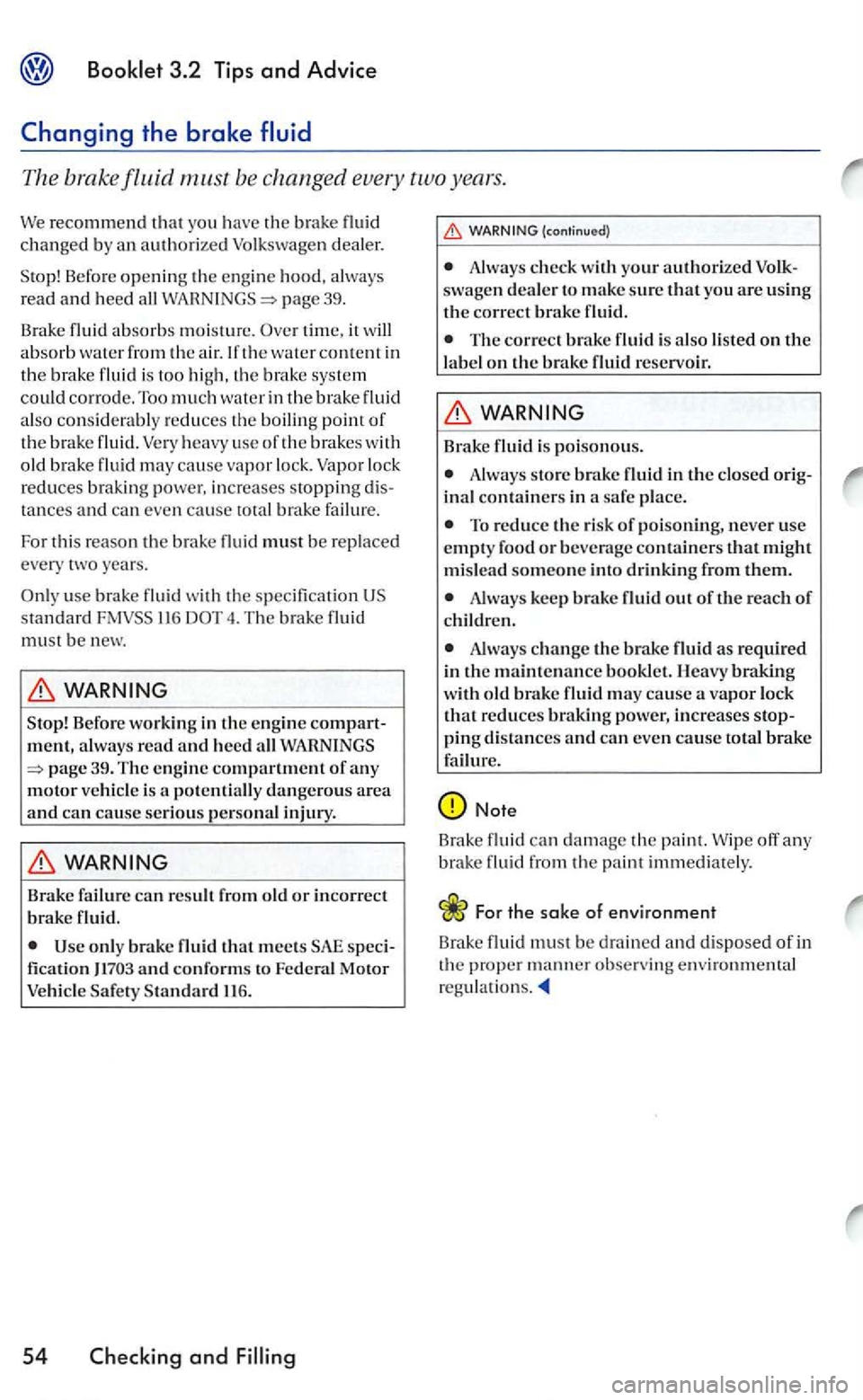
3.2 Tips and Advice
The brake fluid be changed every two years.
We recommend that you have the brak e changed b y an authorize d Volkswagen dealer.
S top! Be
fore openin g th e e ngin e hood, always
read and heed all page 39.
Brake fluid
absorbs m oisture. time, it will absorb wate r from the air. the wa ter content in the brak e fluid is too high, the brake sys te m
c
ould corrode. Too much wa te r in the brak e fluid
a lso consid erably reduces the boilin g point of the brake fluid. Very heavy use of th e brak es with
old brake fluid may cause vapor lock . Vapo r lock
reduces braking power, in cre ases stopping tances and can eve n cause total brake failu re.
For this r
eason the brake fluid must be repla ced
every two years.
use brak e fluid the s pecification U S standard 116 4. The brake fluid must be new.
Stop ! Befor e working in the engine compartment, always read and h eed all WARNINGS 39. The engine compartment of any motor vehicl e is a potentiall y dangerous area and can cause seriou s persona l injury .
Brake failure can result from old or incorrect brake fluid.
fica tio n
(continued)
A lwa ys check with your authorized swage n deale r to make sure that you arc u sing the correct brake fluid.
The correct brake fluid is also listed on the
labe l on the brak e fluid reservoir.
Always store brake fluid in the closed
To reduce th e risk of poisoning, neve r us e empty food or beverage containers that mi ght mislead someone into drinking from them.
A lwa ys keep bra ke flu id out of the reach of childr en.
Alway s change th e b rake fluid as required in the maintenance bookl et. Heavy braking w ith old brake fluid may cause a vapor lock that reduces braking power, increases ping distances and can even cause tota l brake failure.
Note
Brake fluid can damage the pai nt. Wip e off any
brake fluid from rh c paint immedia tely.
For the sake of environment
B rake fluid
must be drained and disposed of in
th e proper manner obse rv ing env ironmental
Page 334 of 444
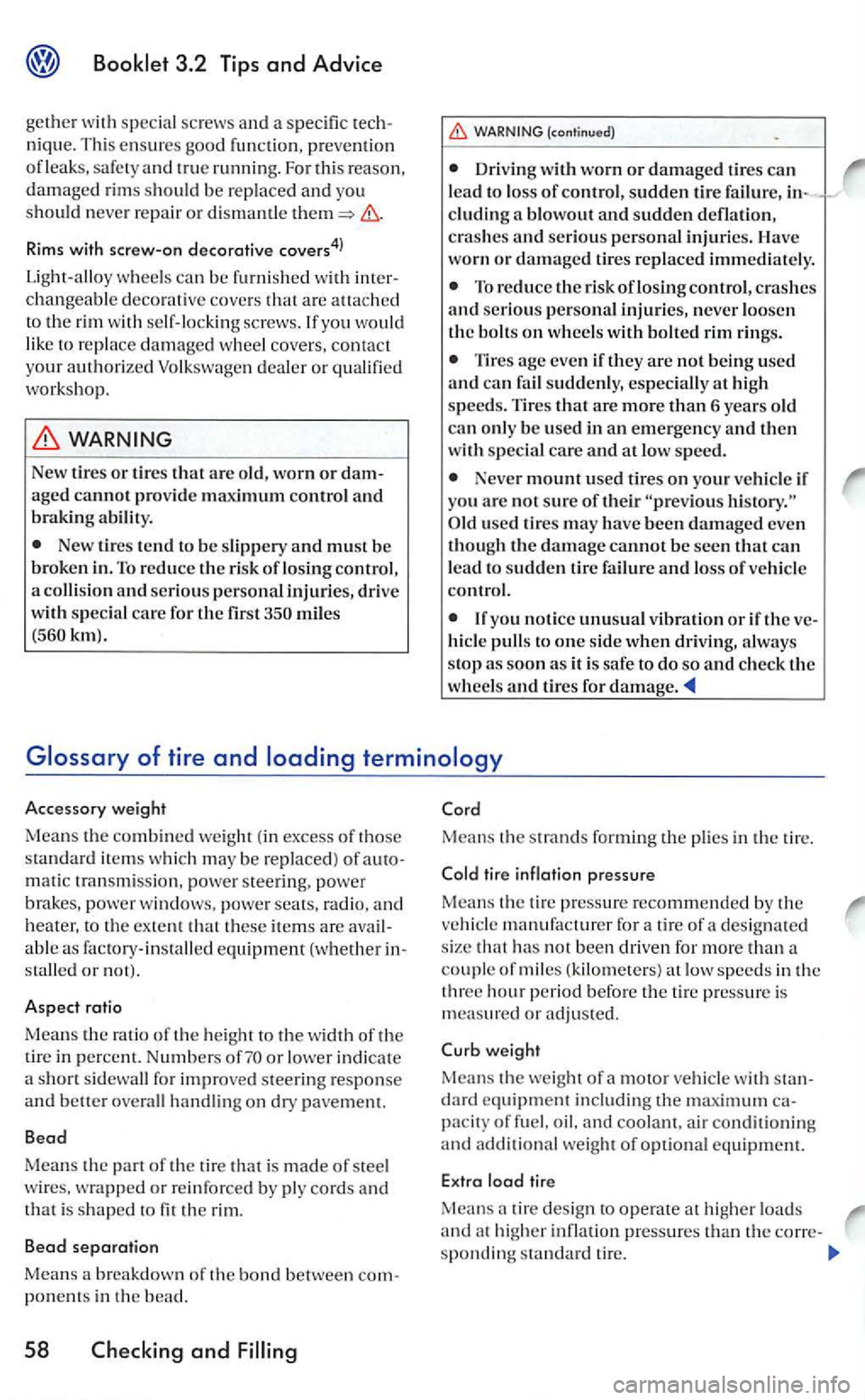
changea ble deco rat ive cove rs a re att ached to th e rim with s elf- locking sc rews . lfyou would ro re pla ce damaged wheel covers, contact your authorized Volkswa gen d eale r or
WARNING
New ti res or tires tha t are old, worn or aged cannot provide maximum control and braking ability.
New tires tend to be s lipp ery and must be broken in . To reduce the risk of losing co ntrol,
a co llisio n and serio us personal injuri es, drive with sp ecia l care for the first km).
(cont inued )
Driving with worn or damaged tire s can lead to lo ss of control, sudden tire failur e, cluding a blowou t and sudden deflation ,
c ras hes and seriou s personal injuries. Have wo rn or damaged tires rep laced imme di ate ly.
To redu ce the riskoflosingcontrol, crashes and s erio us personal injuries, never loose n
th e bolts on w heels with bolted rim rings.
more than 6 years old can onl y be used in an em erg en cy and then
w ith specia l care and at low speed.
Neve r m ount u se d tires on your ve hicle if
yo u are not sure of their used tires may have been damaged ev e n
t h oug h the damage cannot be seen th at can
lead to sudden tir e failure and loss of ve hicl e control.
hicl e pull s to one sid e when dri ving, always
s top as soo n as it is safe to do so and ch eck the
whee ls and tires for damage.
Accessory weight
Means the combined we ight ( in excess of those
sta ndard ite m s w hi ch may be repl aced) of mati c tran smission. power steering. po wer
bra kes, power windo ws. p owe r seats , radio, and heater, to th e ex te nt th at th ese item s are
or lowe r indica te
a short s id ewall for improved steering respo nse and better ove rall handling on dry pave ment.
Bead
Mean s the pa rt of the tire t hat is m ad e of stee l
wires , w rap ped or re inforce d by pl y cords and that is shap ed to fit t he rim.
Bead separation
Mean s a breakdow n of th e bond between
Means the strand s forming the in th e tire.
weight
Me ans th e weig ht of motor vehicl e w ith dard equ ipment including the m aximum pacity of fu el, oil. and coolant . a ir conditio nin g
a nd additional weight of opt io n al equipm ent.
E xtra load lire
M ea ns tire desi gn to operate at higher loads and at hi gher inflat ion pressure s th an th e corre -
s ponding sta ndard tire.
Page 397 of 444
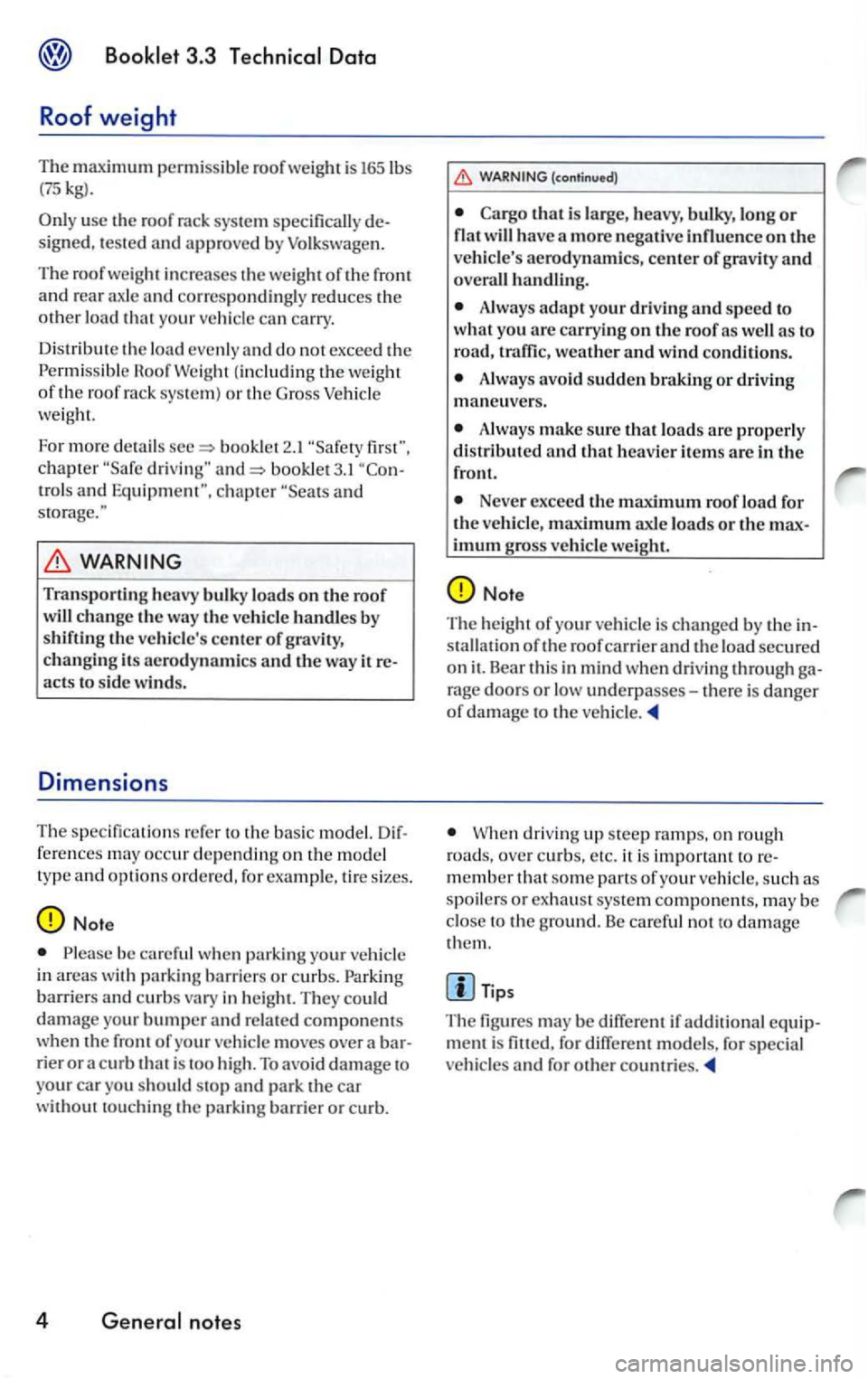
permissible roof weig h t is 165lbs (75 kg).
use th e roof rack syste m specifically designed, tested and approved by Volkswagen.
T he roof weig ht i
ncreases th e weight of th e front and rear axle and correspondingl y reduces th e other lo ad that your ve hicle can carry.
D istribu te the load evenly and do no t exc eed the Roof Weig h t (including the we ight of the roof rack syste m ) o r th e Gross weight .
For
more d e ta ils book let2.1 firs t",
c hapte r dri ving" bookle t3. 1 ''Con
tro ls and Equipment" , chapter and storage."
Tran sporti ng heavy bulky loads on th e roof w ill change th e way th e ve hicl e handles by shifting the ve hicle's center of gravity, changing its aerod ynamics and the way it r eacts to side winds.
Dimensions
T he s pecificatio ns refe r to the basic model. Dif
f erences may occur dependin g on the model
type and optio ns o rd ere d, fo r exa mple. tire s izes.
be careful when parking your vehicl e
i n areas with parking barriers or c u rbs. barriers and cu rbs vary in heig ht. They could damage your bumper
(continued)
t hat is large, heavy, bulky, long or
Always adapt your driving a nd speed to
w hat yo u arc carryi ng on th e roof as well as to
road , traffi c, weath er and wind co nd it io ns.
A lways avoid sudden brakin g or driving mane uve rs.
A lways make su re th a t loads are properly
d istribute d and that heavier it em s are in th e
fro nt.
Neve r exceed the maximum ro of load for the ve hicle, maximum axle loads or th e maximum gross vehicl e w eigh t.
When drivi ng up steep ramps . o n roug h
road s, over curb s, etc. it is important to remember that some part s of your vehicl e, s u ch as
s poiler s or exhaust sys te m components, may be
close to th e g round. Be ca reful no t damage them.
Tips
The figures may be d ifferent if ad ditio nal equipment is fitt ed, for different models, for special
ve hicles and for ot11er